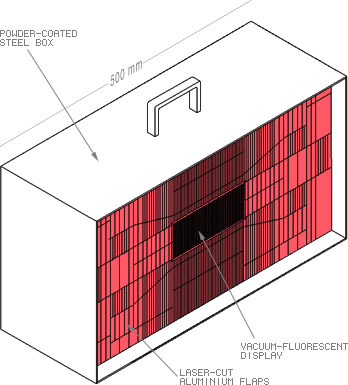The cellular noise-maker is a portable steel box comprised of a central fluorescent display surrounded by a pattern of aluminium flexible flaps. It resembles a large portable radio, and can be carried around, keeping the house's occupants company. As data is received by the device from other noise farming devices, it is stored in its memory and shown as an intricate pattern of dots on the central display (1). When its memory is full, the noise-maker uses its stored data patterns as a score to generate a sound burst of many simultaneous clicking noises by using electromagnets to rapidly move the flaps on its surface (2). The clicking noise ends in a sharp FM radio pulse (3) which is a highly compressed data burst of all its memory contents. Following this, the memory is wiped and the process starts again.
